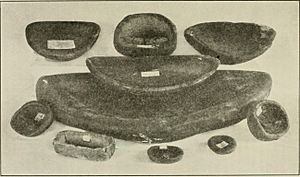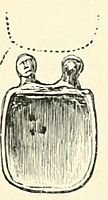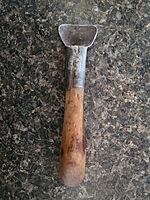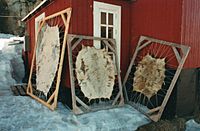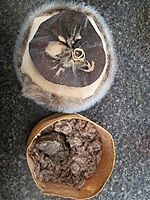Qulliq facts for kids
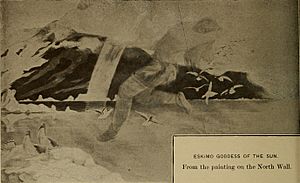
The qulliq (pronounced kool-lik) is a special oil lamp. It was traditionally used by people living in the Arctic. These include the Inuit, the Chukchi, and the Yupik peoples.
This unique lamp was very important for survival in the cold Arctic. It gave both warmth and light. In the Arctic, there was almost no wood. People relied on seal oil or whale blubber for fuel. The qulliq was the most important item in their homes.
Contents
History of the Qulliq
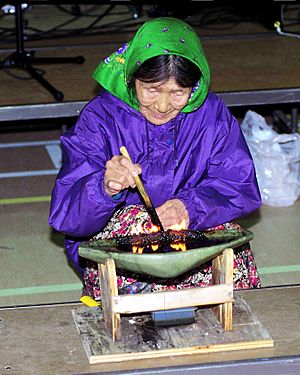
We don't know exactly when people started using seal-oil lamps. They are part of many new tools developed by Arctic peoples over time. Oil lamps have been found at sites from the Paleo-Eskimo communities. These date back about 3,000 years ago.
The lamps were also common for the Dorset culture and the Thule people. The lamps made back then look very similar to more recent ones. This shows how well they were designed.
Qulliq in Inuit Stories
In Inuit religion, the qulliq appears in important stories. One story is about the Sun and the Moon. The sun goddess, Sukh-eh-nukh, carries an oil lamp. She accidentally tips it over. Oil and soot spill onto her hands. She then blackens the face of her brother, the moon god Ahn-ing-ah-neh.
Among the Netsilik Inuit, there's another story. If people broke certain rules, Nuliajuk, the Sea Woman, would hold sea animals in her lamp's basin. This meant no animals for hunting. A spiritual leader called an angakkuq would then visit her. He would ask her to release the animals for the people. This story also inspired a New Year tradition. Three lamps were put out and relit during the first sunrise of the year.
Past and Present Uses
In the past, the qulliq was a multi-purpose tool. Arctic peoples used it to light and heat their homes. These homes included tents, semi-underground houses, and igloos. The lamp was also used for melting snow to get drinking water. It helped them cook food and dry their clothes.
Today, these lamps are mostly used for special ceremonies. The qulliq is very important culturally. It is even shown on the coat of arms of Nunavut.
A qulliq was lit during a very important event on July 26, 2021. This was the ceremony for Mary Simon. She became the first Inuk and Indigenous person to be the Governor General of Canada. The lamp was lit in the Senate Chamber.
How the Qulliq Was Made and Used
Inuit oil lamps were mainly made from soapstone. Some were also made from a special kind of pottery. The lamps came in different sizes and shapes. Most were either oval or shaped like a half-moon.
Lamp Tools and Wicks
The taqquti (pronounced tak-koo-tee) were tools used to trim the wick. They were also called lamp feeders. These tools were made from wood, willow, soapstone, bone, or ivory.
The wick itself was usually made from Arctic cottongrass or common cottongrass. Sometimes, dried moss was used. The wick was lit along the edge of the lamp. This created a soft, pleasant light. A piece of seal blubber could be placed over the lamp. It would slowly melt and feed more fat to the wick. People had to keep trimming the wick. This stopped the lamp from making too much smoke.
Fuel for the Lamp
These lamps were usually filled with seal blubber. That's why they are often called 'seal-oil lamps'. But in communities where people hunted whales, whale blubber could also be used. However, the term 'whale-oil lamp' usually refers to a different type of lamp.
Fat from land animals like caribou was not as good. Seal oil was a much better fuel for the lamp. Women would carefully scrape the skin of a freshly hunted seal. They used a special knife called an ulu to make sure no fat was wasted. After the seal skin was stretched and dried, it would be scraped again. This time, a tool called a halukhit was used to remove any dried fat.
Arctic explorer William Edward Parry saw how important these lamps were. He noted that "when the family moved the lamp went along with it." He described the lamp:
The fire belonging to each family consists of a single lamp or shallow vessel of lapis ollaris, its form being the lesser segment of a circle. The wick, composed of dry moss rubbed between the hands until it is quite inflammable, is disposed along the edge of the lamp...
Images for kids


